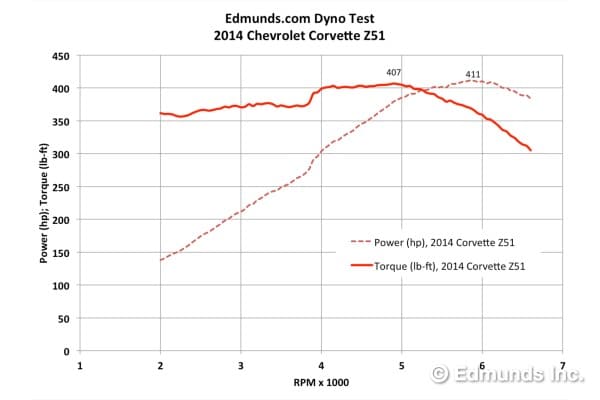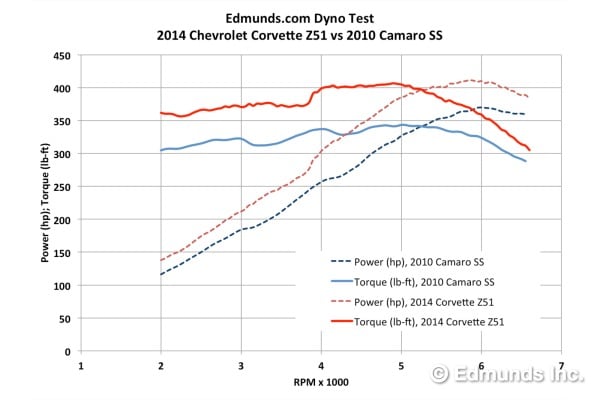
Here it is, the world's first independent chassis dyno test of the 2014 Chevrolet Corvette Stingray, or C7.
You already know all about the C7's LT1 engine because you read our Gen 5 engine backgrounder. You know that it is equipped with direct injection for the first time, and that at the flywheel it churns out 460 horsepower and 465 pound-feet of torque (with optional performance exhaust). Heck, you're such a devoted reader that you've memorized our Corvette Stingray Road Test.
To learn more about the manner in which the C7's power is delivered to the wheels, we strapped a 2014 Corvette down to MD Automotive's Dynojet chassis dyno.

Specifically, the car you see here is an early-VIN Z51 with the performance exhaust option, which adds 5 hp and 5 lb-ft of torque. So, yeah, you're buying that exhaust for the sound. And it's a sound that will be familiar to anyone who has been within earshot of a Corvette at any point in the last 15 years or so. The LT1 may be heavily revised, but it's still a pushrod, big-cube, crossplane V8, and it still sounds like one.
Here's how it performed on the dyno:

Back when GM's engine nerds first told us about the LT1, they stressed its big gains in low-speed torque. They weren't kidding. It's one stout mill down low. At no point between 2,000 and 6,000 rpm does the Stingray generate less than 350 lb-ft of torque.
There's also an upward bump in the torque curve at 3,800 rpm that coincides with the exhaust bypass valves snapping open to unleash the LT1's full-throated bellow. This bump is a characteristic not normally seen on GM V8s (they typically exhibit a rounded dome of a torque curve) but nobody's likely to complain. As a result of the bump, peak torque of 407 lb-ft (at the wheels) arrives at 4,900 rpm just before it precipitously rolls off on its way to the fuel cut.
Peak power of 411 hp (again, at the wheels) arrives just a thousand revs after the torque reaches its maximum, but clearly this is an engine with a broad-shouldered and flexible power delivery.
For kicks, here's how the C7's dyno result compares to the LS3 in our erstwhile long-term 2010 Camaro SS. The Camaro was originally rated at 426 hp at the flywheel.

Note the across-the-board gains despite no change in displacement, rev ceiling or even valve lift (the LT1 uses virtually the same cam profiles as the LS3) between the LS3 and LT1.

The Stingray's direct injection (DI) is key to the engine architecture's newfound vigor. DI's cooling effect facilitates a bump in the compression ratio and improves volumetric efficiency by not plugging the intake ports with fuel mist.
OK, Ford fans. Here's where you get to gloat. Below is how the Stingray stacks up against the 2013 Ford Shelby GT500's supercharged monster mill. Additional words aren't really needed here, only to add that these cars are a bit like apples and kiwis despite their price similarity.

Nevertheless, the LT1 is a worthy addition to the Corvette legacy, especially when you consider that what we see here is the base Corvette. It's the new normal, and there are the inevitable higher-zoot C7 variants in the pipeline.

When we tested a different C7 at GM's Milford Proving Ground, it laid down a startlingly high trap speed of 117.3 mph. It's an open question whether the car you see here — fueled as it is with California's best premium fuel of 91 octane instead of the 93 or 94 octane that was in the Milford car — can duplicate that performance. One that we'll be answering very shortly.
The manufacturers provided Edmunds these vehicles for the purposes of evaluation.